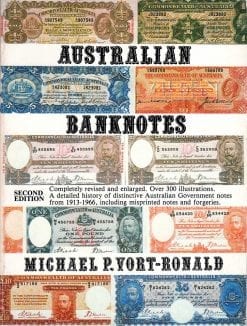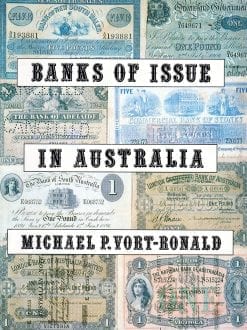- Selection Required: Select product options above before making new offer.
- Offer Sent! Your offer has been received and will be processed as soon as possible.
- This popup will automatically close in 5 seconds.
- Error: There was an error sending your offer, please try again. If this problem persists, please contact us.
Australian Banknote Pedigrees
$95.00 Original price was: $95.00.$65.00Current price is: $65.00.
Author: Michael Vort-Ronald
Hardcover: 500 pages.
Published: 2005.
Signed by the author.
One only in stock
SOLD
Includes hammer prices for superscribed, pre decimal, decimal general issue and star* banknote replacements from 1975 to 2005. Serial numbers listed, prices advertised, many dealers lists.
PREFACE
I commenced to collect Australian pre-decimal coins “for my children”, not long after the introduction of decimal currency in 1966. but soon found pre-decimal Australian notes much more interesting because of their history, beauty and relative scarcity. In those early days when collectors of Australian notes were comparatively few, Max Stern offered 1918 five pound notes for sale from a hoard for as little as $14 each, and my interest ( some might say obsession) for the next thirty five years was assured.
The first major auction I attended was the Spink (London) Auction in Sydney in 1975 where I purchased on behalf of an American friend (George Kershner) a Cerutty / Collins Ten Pound note for $850. For many years I attended major auctions in Sydney and Melbourne and later acquired that note for my own collection from George.
I was also probably the first person to assemble duplicate decimal banknote collections at a time when most other collectors were still taking for granted that all decimal varieties were still easily obtainable. In about 1986 Keith Deutsher found that he could not buy a then complete collection of uncirculated decimal notes anywhere, and swapped me a set of ten oval decimal specimen notes in a book for a duplicate collection that I annotated in an album. Those hand-typed albums became due genesis of my numerous editions of printed interleaves and banknote albums.
I set about collecting all known varieties of Australian notes from 1913 (and some private bank issues) and decimal star notes by all 50 serial letter prefixes. I had the privilege of once owning a fifty pound note, two one hundred pound notes and all three varieties of the twenty pound note, including the note that once “sold” for $32,000 at auction, which I later purchased at a reserve price of $5,000. The other two twenty pound notes were financed by the sale of 32 decimal star notes surplus to my pairset by signatures and decimal star note prefix collection. In 1988 I sold my banknote collection through Spink Auctions for $330,000 and used the proceeds to purchase a 1873 bank building to set up the Banking and Currency Museum at Kadina. Today, the notes from that collection are worth well over one million dollars.
To accumulate data for my research and books I kept hand-written records of Australian notes in auctions from 1975, particularly where a serial number was listed, illustrated or known from pre-auction viewings. With over ten pages of listings for some notes, it became increasingly difficult to keep track of just how many or which notes had appeared in auctions, and how often each note had been offered for sale. Toassemble thirty years of data into a more useful format required me typing all of my records into numerical order, and Australian Banknote Pedigrees is the result.
This book will enable collectors and investors to see where and when the majority of Australian notes appeared for sale in the past 30 years, and their fluctuating conditions and prices. When collating the material it seemed evident that some investors were buying and selling some notes in a similar fashion to investing in the stock market and the ever-increasing prices realised for good notes in the past twenty years has proved notes a very sound investment. This makes it more difficult for “real” collectors to obtain notes for their collections, but at the same time increases the values of the notes they already have. Good luck with your collecting. Mick Vort-Ronald, March 2005.
3
Related products
Australian Decimal Banknote Paper Issue Interleaves Album. Australian Decimal Banknotes 1966-1994. One Dollar to One Hundred Dollar. Author: M. Vort-Ronald.
Author: Michael Vort Ronald.
Author: M. Vort Ronald Second Edition: 2008 Australian Shinplaster & Calabash Notes
Leuchtturn Banknote album with Vario Binders












